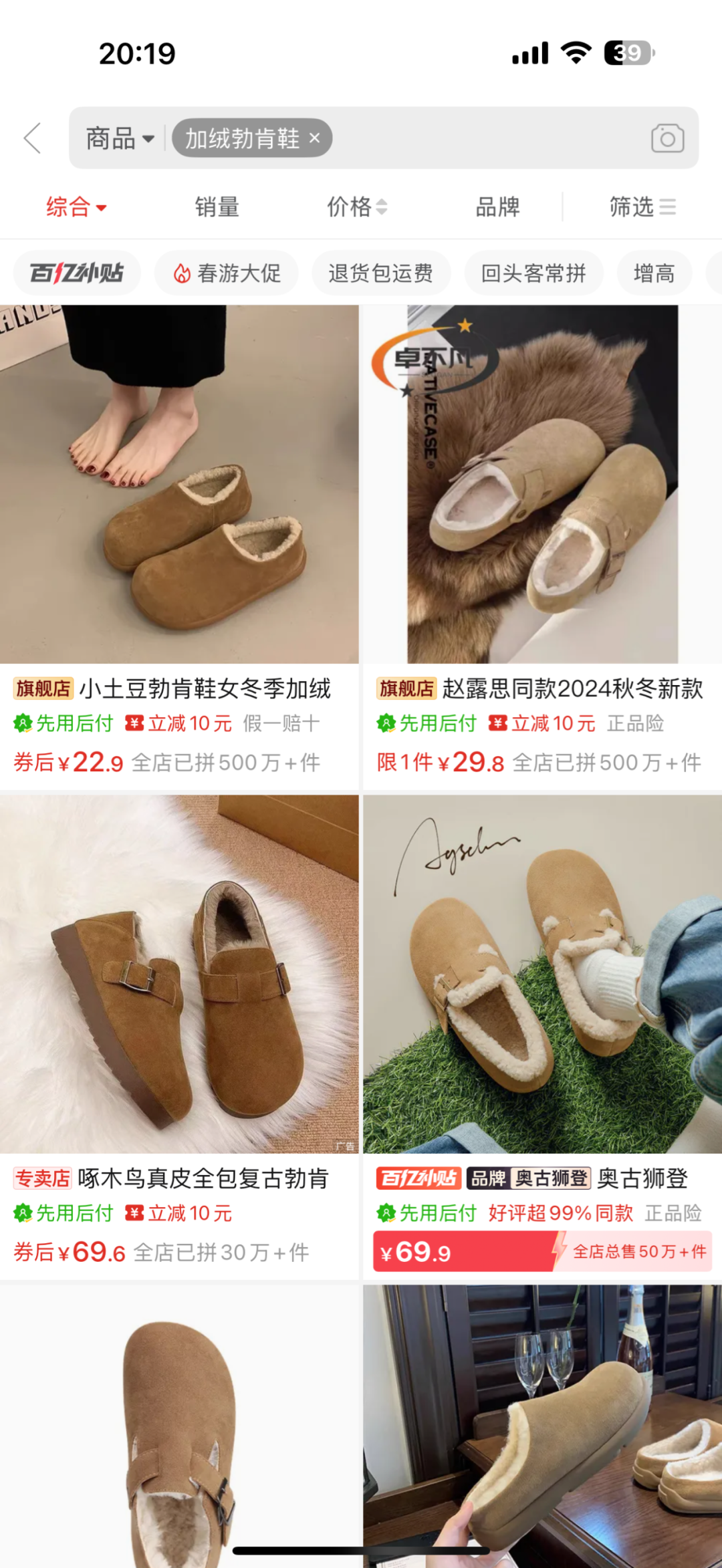E-commerce New Force 2025: Revolutionizing Bidirectional Supply and Demand
![]() 04/11 2025
04/11 2025
![]() 455
455

In 2018, when Pinduoduo debuted on the Nasdaq, Daniel Zhang of Alibaba and Liu Qiangdong of JD.com were both asked about their perspective on the company and the competition it posed. Their responses, despite differing in detail, shared a common thread. Zhang remarked, "Of course, everyone loves a good deal, but quality matters too." Liu countered, "Shop around China a few times, and you'll find your answer."
Between the lines, it's clear: the emerging lower-tier market would inevitably embrace the joys of consumption upgrading.
The rationale is straightforward. In 2019, JD.com and Alibaba both flourished, with JD.com's Non-GAAP net profit soaring 211% to RMB 10.7 billion, while Alibaba's growth was a more modest 12% but still totaled RMB 93.4 billion. More importantly, their narrative dominated e-commerce, becoming an unshakable industry standard.
Based on traffic distribution, top suppliers willingly invest in marketing and "traffic taxes" to grow their presence, leading to higher platform commissions. In turn, the platform boosts its value by purchasing traffic and continuously supporting top suppliers.
In "The Innovator's Dilemma," Clayton Christensen outlined a strategy to outmaneuver incumbents: weaken their foundation or create a new market. Innovation introduces simple, convenient, affordable products into markets dominated by complexity and high prices, ultimately redefining the industry.
In the e-commerce landscape, technological advancements and shifting perceptions have empowered new players to restructure supply and demand for established players through new infrastructures like social fission, interest-based recommendations, and private domain traffic.
Yet, the significant role played by the "Equality Revolution" in this transformation often goes unnoticed.
1
"Equality Revolution"
Once, the lower-tier market and consumption upgrading seemed mutually exclusive.
When Pinduoduo launched its RMB 10 billion subsidy program in 2019, JD.com and Alibaba responded with Taote and Jingxi Pinduoduo, respectively. However, Jingxi Pinduoduo lasted only a year and a half, marked by rapid urban withdrawals, layoffs, and mergers. Taote persisted until 2022, amassing 300 million annual active consumers but at a cost of RMB 30 billion in losses to Alibaba through Taote and Taocaicai in the first three quarters of 2021.
Post-event analysis concluded that using consumption upgrading to tap the lower-tier market wouldn't work. The reason remained elusive.
One theory posits that "low prices" reign supreme in the lower-tier market, where consumers tolerate product flaws for the sake of affordability. Pinduoduo, however, spoke from experience, revealing that consumers beyond the Fifth Ring Road aren't solely price-conscious.
The RMB 10 billion subsidy program from 2019 facilitated Pinduoduo's transition from white-label to branded products. However, the true intention wasn't to align with the latter but to pave the way for the nascent concept of "demand equality."
Demand equality involves breaking the traditional consumption hierarchy through new infrastructures like social fission, interest-based recommendations, and private domain traffic, ensuring equal treatment and satisfaction of user needs.
Consider Guo Degang's joke: drinking coffee isn't inherently elegant, and eating garlic isn't necessarily vulgar. It's about individual needs in different contexts.
In other words, if someone is thirsty, the platform needn't recommend an expensive coffee or alcoholic beverage. A moderately priced bottle of mineral water might better suit their needs. There's no hierarchy in demand; the key is proper satisfaction.
Demand equality redefines the consumption hierarchy in e-commerce, emphasizing the satisfaction of a broader range of user needs rather than catering to a niche high-consumption group. New infrastructures like social fission, interest-based recommendations, and private domain traffic serve as telescopes for discovering these broader needs. Supply equality, its counterpart, is the conveyor belt for meeting those needs.
Like demand equality, supply equality's value lies in giving consumers the choice between branded and white-label products, letting real demand dictate supply.
The platform's role has evolved from a traffic (interest) distributor to a value linker, ensuring users' diverse needs are fully met.
The epitome of supply equality in e-commerce includes agricultural products going straight from farm to table and unbranded factory goods in livestreams. A "replacement storm" illustrates this perfectly.
This trend persists because rational consumption is gaining ground, and beyond RMB 9.9 trash bags and tissues, numerous categories still have unmet replacement needs.
Addressing this demand is a fresh topic in supply.
2
"New Quality Supply"
Almost all major US retailers have embarked on the same path: introducing private brands, such as Walmart's George and MM, Sam's Club's Member's Mark, and Costco's Kirkland. Essentially, these are white-label products exclusive to their stores.
These products are custom SKUs developed by the retailers, leveraging their market share to force OEM factories to comply. They offer pricing and supply chain cost management advantages, enhancing retailers' competitiveness. In 2024, Kirkland contributed one-third of Costco's revenue.
Whether custom SKUs or proprietary brands, the core is channel-driven supply transformation.
In China, physical retail apprentices have followed a similar path, but e-commerce has led the way in broader and deeper transformations.
E-commerce's first half saw the connection and reorganization of upstream and downstream supply chains, forming a concentrated online retail market and shortening transaction links. The second half learns from US retailers by transforming supply through channels.
However, large retailers' supply reforms rely on their channel advantages. Walmart and Sam's Club boast more stores and SKUs, while Costco leverages member loyalty and repurchase rates. E-commerce newcomers' supply reform is more rooted in the broader needs uncovered by demand equality.
In other words, as user needs are discovered, supply must adapt.
Supply reform's primary challenge is the manufacturing industry's long-standing issue: strong manufacturing but weak branding.
Huidong County, Guangdong Province, once known as the "production base of women's shoes in China," accounted for over 80% of global women's shoe production at its peak. However, due to strong manufacturing but weak branding, nearly 5,000 shoe factories in Huidong had little anti-risk capability.
Last year, however, a pair of "ugly and tacky" fleece Birkenstocks propelled Huidong County back into the spotlight. On Xiaohongshu, the hashtag #How to clean dirty fleece Birkenstocks# garnered over 30,000 notes. On Pinduoduo, sales of single items priced below RMB 100 exceeded 5 million pieces.

Behind the fleece Birkenstocks' popularity lies a tale of channel-driven supply transformation.
Initially, Huidong merchants spotted the Birkenstocks trend and developed a fleece version for autumn and winter. However, fierce competition upon launch prevented sales from skyrocketing.
Last September, attracted by Pinduoduo's increased investment in "new quality supply," Huidong's struggling shoe factories seized new opportunities with platform policies like "RMB 10 billion exemptions," "e-commerce westward," and the "new quality merchant support plan," along with support from the platform's digital technology and resources. One medium-sized shoe factory alone shipped 15,000 pairs daily.
Similar cases include Quanzhou diapers, Cangzhou beauty brushes, Cixi small appliances, Pingdu fake eyelashes, Donghai wearable nails, and Bozhou herbal tea. These new quality supply transformations share key factors:
Strong merchant innovation willingness and capabilities, coupled with robust platform support (data openness, cost reduction).
Cost reduction is crucial. Fu Qiu from Huidong County is a case in point. Due to platform support measures, the sales cost per pair of Birkenstocks he sells decreased by 40%. A pair originally priced above RMB 150 now sells for just RMB 90 on Pinduoduo.
This year, Pinduoduo launched the "RMB 100 billion support" plan, building on the "RMB 10 billion exemptions": over the next three years, Pinduoduo will invest over RMB 100 billion in funds and resources on the supply side to help merchants transform and upgrade under the new quality production trend.
Pinduoduo CEO Lei Chen's statement during the Q4 earnings call provides context for the "RMB 100 billion support" plan:
Currently, we observe a certain degree of homogeneous competition in some industrial chains. Long-term homogeneous supply compresses merchants' profits, significantly inhibiting innovation momentum and investment intensity.
Occupying merchants may seem contradictory to previous consumer-centric demand equality, but the logic remains: benefiting merchants benefits consumers. As consumer needs are discovered, new quality supply must satisfy them, whether branded or white-label products, or new product or service forms.
In the case of fleece Birkenstocks, two points stand out. First, factories, as producers, began studying market trends and seeking the "traffic password." Second, the platform's role extends beyond transaction matching, acting as an accelerator for efficient information matching between supply and demand.
The "RMB 100 billion support" plan aims to economically incentivize merchants, enabling them to grow into new quality supplies that understand both production and the market, becoming the core assets of China's next-generation e-commerce supply chains.
3
Epilogue
Over the past five years, a recurring question has been: how could Pinduoduo emerge amidst giants like Alibaba and JD.com in the e-commerce market? In the past two years, Douyin and Tencent have also joined the fray.
Rephrased, where did Pinduoduo, Douyin, and Tencent find market increments?
The answer lies in the "Equality Revolution," from demand equality to supply equality, as e-commerce newcomers depict a new landscape of efficient information matching.
Behind efficient matching lies an upgrade in platform rules. In essence, e-commerce newcomers have altered the platform's behavioral logic:
From customer collusion to user co-governance, always thinking from the consumer's perspective.
The old traffic distribution mechanism not only skews scale but also increases hidden consumer costs. Under new rules, timely demand discovery and satisfaction lead to merchants' new quality evolution, enhancing user experience and securing a high-quality supply chain for the platform.
It's precisely because these new forces enable more real needs to be efficiently matched that the old and new can coexist and alternate.
Disclaimer: This article is based on publicly available information or data provided by interviewees. Decode and the article author do not guarantee the completeness or accuracy of such information. Under no circumstances should the information or opinions expressed in this article be construed as investment advice.







